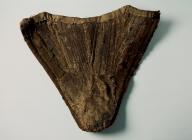Keeping evil at bay: Concealed garments
Items in this story:
Beneath the floorboards
Renovating an old house? Stay alert! Who knows what you'll find beneath the floorboards or behind the walls. You might discover a deliberately concealed garment, hidden by a previous occupant to bring good luck and fertility to the home. These concealments are called 'caches' — a term deriving from the French word 'cache', meaning 'to hide'. St Fagans: National History Museum has collected several caches over the years. Each new find provides a valuable insight into this little known but widely practiced folk custom.
Hidden shoes
The most frequently found hidden garments are shoes. They are usually discovered near chimneys or fireplaces, but rarely are they found in pairs. Children's shoes are the most commonly found garments. This mid 19th century leather shoe was discovered in 1994 behind a fireplace in a stone built house in Llanfachreth. The owners found four other shoes in the same location, each well-worn and in a degraded condition. They almost certainly belonged to a family unit of two parents and three children.
Chimneys and fireplaces were probably chosen as hiding places because they served as the main focal point in most homes — a source of heat and comfort and an important place to congregate as a family. Shoes were also hidden under floorboards, around doorways and below staircases. Some considered these places to be the weakest part of a building, where evil spirits and witches would enter. Shoes were placed in these areas in order to trap or corner potential evil.
A concealed corset
Although shoes are the most frequent finds, other types of garments have also been discovered — for example, hats, jackets and breeches. This fragment of a corset was found in a thatched cottage in Cae Cerrig Road, Pontarddulais. It was discovered in 2002 lying in soil behind a thick wall to the side of the fireplace. Dating from the mid 18th century, it is roughly heart-shaped and is constructed from three layers: an outer layer of buff coloured wool, a stiffening layer of whalebone strips and a linen lining. Evidence of silk stitching remains in some areas. In its original condition, this fragment would have formed the front panel of the corset, covering the chest and abdomen.
What should you do if you find a concealed garment? If possible, avoid excessive handling and contact your local museum for further guidance. Remember to take plenty of photographs or drawings of the garment in its found location. Above all, stay vigilant — that heavily worn 'rag' could be a piece of history!


